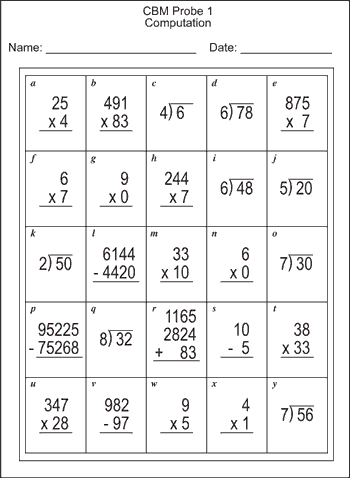How can teachers use assessment to guide instruction?
Page 2: Progress Monitoring
For Your Information
Although this module focuses on GOM, mastery measurement is another type of progress monitoring. Though similar in a number of ways, GOM and MM serve different purposes. Whereas GOM assesses long-term goals (i.e., the acquisition of skills across an entire school year), MM assesses short-term objectives (i.e., the acquisition of specific skills within a unit of study). To learn more about the differences between GOM and MM, view the following IRIS Information Brief:
Progress monitoring is a type of formative assessment that elementary, middle, and high school educators can use to:
- Frequently and continuously evaluate student learning
- Monitor the effectiveness of their instruction
- Make instructional changes to improve students’ academic progress
When people use the term progress monitoring, they are typically referring to a type of progress monitoring known as general outcome measurement (GOM). GOM, often referred to as curriculum-based measurement (CBM), monitors student growth toward a long-term goal.
GOM is an effective means of assessing and tracking student progress on skills across the entire curriculum. It is conducted on a regular basis—for example, once a week— by giving a short test (i.e., a measure or probe) to a student or a group of students. Typically, each of these tests includes sample items designed to evaluate every skill in the instructional curriculum for a specific grade level (i.e., curricular sampling or curriculum sampling). Because GOM is administered frequently, each test should contain equivalent but different items. These are referred to as alternate versions or alternate forms.
The tests below represent a beginning-of-year measure and an end-of-year measure. Note that they are alternate versions consisting of different but equivalent items.
Beginning-of-year probe

End-of-year probe

For Your Information
Although math progress monitoring measures generally use the curricular sampling approach, reading measures more commonly use the overall indicator approach, in which test scores correlate with overall reading performance. For more information on progress monitoring in reading, check out the following IRIS Module:
Educators do not use progress monitoring to assign grades. Rather, they score probes to measure student progress. Students are not expected to demonstrate immediate mastery of the skills in question. It’s normal for scores to be low at the beginning of the year and improve over time, which is an indication that students are learning.
There are many benefits to using general outcome measurement to monitor student progress. In addition to those already mentioned, educators can use GOM data to:
- Monitor student progress over time
- Determine whether the current instruction is helping students to learn
- Determine whether students are making adequate progress toward their learning goals
- Identify students who are not making adequate progress and to provide additional or alternative instruction
- Check for retention of previously taught skills (i.e., skill maintenance)
x
maintenance
glossary
- Predict student performance on the year-end assessment
- Effectively communicate academic performance to students, parents, and other school professionals
Did You Know?
GOM can be used to determine whether an educator is providing high-quality instruction. When educators provide high-quality instruction, most of their students will show growth in mathematics skills across the year. However, if many students are not demonstrating sufficient improvement, the educator may need to improve the quality of instruction. For more information on implementing high-quality mathematics instruction, view the following IRIS Module:
Below, Lynn Fuchs talks more about the benefits of using progress monitoring probes that sample the entire year’s curriculum (time: 1:03). Next, Jessica Sellers discusses how she used progress monitoring to evaluate student performance and adjust her instruction in an ongoing manner (time: 0:39).

Lynn Fuchs, PhD
Dunn Family Chair in Psychoeducational Assessment
Department of Special Education
Vanderbilt University
Transcript: Lynn Fuchs, PhD
Because the CBM curriculum-sampling approach has the advantage of sampling the entire year’s curriculum, rather than a single skill, it provides teachers with more useful information for program planning but may also be more representative of the student’s overall response to the intervention program.
Sampling the annual curriculum in the same way over time, we can compare a student’s performance in October to a student’s performance a month later, and a month after that, and so on. This helps us understand their response to the overall program, not just on a particular skill in the program. Curriculum-sampling can also help teachers identify which particular skills are problematic for which students, and this can help them form productive instructional groups.
Transcript: Jessica Sellers, MEd
Progress monitoring has been helpful for me to gauge how well a student is performing and how to increase that performance. I don’t have to wait for the end-of-year tests to see how a student will perform. I can see if my instruction is increasing student learning and make adjustments throughout the year. This takes a lot of the stress out of standardized testing. By the end of the year, I know I’ve increased student learning through my instruction because I’ve tracked their growth all year. I have the graphs to prove it. And if a student isn’t doing well, I know right away and I find out what that child needs. If I didn’t use progress monitoring, I might not notice just how far a child is behind. It might not even show up until we take the end-of-year tests, and by that time it’s too late.
Research Shows
Research into the effectiveness of CBM has been ongoing for more than 40 years. Below are just a few of those findings.
- Struggling students reported that they enjoyed monitoring their progress in mathematics and felt more motivated to learn. Additionally, their mathematics performance improved significantly as a result of progress monitoring.
(Fuchs et al., 1997) - CBM can be used to predict success in traditional year-end standardized assessments.
(Good et al., 2001) - The performance of all students (high-, average-, and low-achieving students, students with disabilities, as well as those with and at risk for mathematics difficulties) improved when teachers modified their instruction based on CBM data.
(Lembke et al., 2022; Stecker et al., 2005) - When teachers received ongoing coaching and implemented frequent progress monitoring, middle school students with mathematics learning difficulties demonstrated improved performance on algebra outcome measures.
(Powell et al., 2021)
GOM data can also help educators to improve the academic growth of at-risk students or students with disabilities. These data can assist educators in identifying students who may need a change of instruction or additional educational support. Educators can use GOM data to:
- Compare the effectiveness of different instructional strategies
- Identify students who are not making adequate progress in a general education setting and who may therefore require additional supports
- Track progress toward goals outlined in the individualized education program (IEP) for students receiving special education services
x
individualized education program (IEP)
glossary
- Identify skills with which students are having the most difficulty

Lynn Fuchs, PhD
Dunn Family Chair in Psychoeducational Assessment
Department of Special Education
Vanderbilt University
Transcript: Lynn Fuchs, PhD
CBM can help teachers improve the learning outcomes of their at-risk students and students with learning disabilities. Teachers can use CBM data to improve the learning outcomes of their students, and they can use CBM in two ways for that purpose. First, they can compare rates of development under contrasting instructional interventions, and in that way, they can identify which instructional components result in optimal growth rates. In addition, CBM data can help pinpoint the kinds of instructional programs and the academic skills specifically that students need more help in. And in that way, teachers can direct their instructional effort more efficiently to only use program components that actually result in good growth for students and to use their instructional time to tailor the specific skills that students are in need of working on. CBM can help teachers not only to assist them in developing strong instructional programs but also in communicating specifically and efficiently about students’ academic development. So the information on CBM most typically is graphed across time, and those graphs can be shared with other teachers, can be shared with principals, and with parents to help those individuals understand in a very concrete way the rates of development that students are experiencing. In addition, the CBM data can be aggregated across students to help teachers understand for themselves how well they’re doing in affecting growth for their classrooms of students.
For Your Information
-
Progress monitoring is a key component in a multi-tiered system of supports (MTSS) or response to intervention (RTI) framework for both elementary and secondary students. The data are collected and graphed to provide an objective way for educators to determine whether students are responding to instruction or intervention. This process can be used by those responsible for each tier of instruction (e.g., general education teacher, interventionist, special education teacher). For more information, view the following IRIS Module:
-
Progress monitoring is also a critical component of data-based individualization (DBI), a research-based process for using data to make instructional decisions for struggling learners or students with disabilities. DBI is often used by educators who work with students who receive individualized, intensive intervention in an MTSS or RTI model. A meta-analysis of research studies (Jung et al., 2018) indicates that the use of GOM within a DBI framework is beneficial to students across reading, mathematics, and spelling/writing. For more information, view the following IRIS Module:
xmeta-analysis
glossary
The GOM Process
Regardless of whether GOM is used to track the academic progress of typically achieving students, struggling students, or those with disabilities, the overall process of collecting and interpreting GOM data to monitor progress and guide instruction is the same:
- Select a measure
- Create a graph
- Create a goal line
- Administer, score, and graph
- Make data-based instructional decisions
- Communicate progress
The remainder of this module will describe and demonstrate each of these steps in detail.
